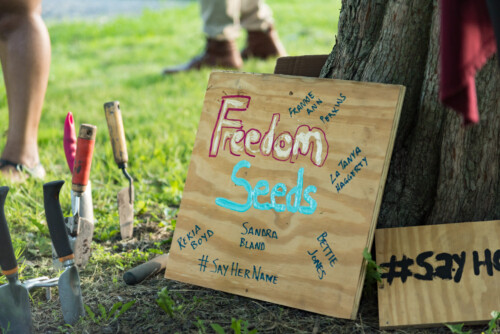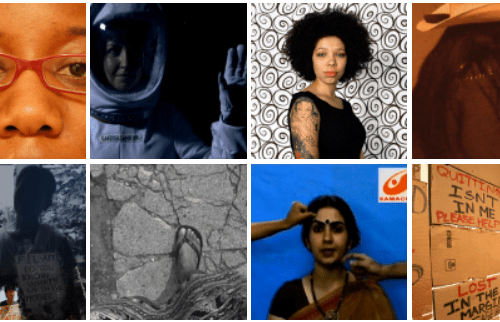The following is an edited transcript of the comments that journalist and author Victoria Law made during “Policing Motherhood” at Invisible No More in November 2017. In her remarks, Law brings Dorothy Roberts’s opening analysis and statistics to life with two poignant stories uncovered in her reporting on women, gender, and criminal justice issues that clearly illuminate the many mutually reinforcing systems of policing and punishment in the lives of mothers of color. Picking up the themes in Jeanne Flavin and Lynn Paltrow’s “Do No Harm” in this issue, Law’s stories also highlight the operation of mandated reporting laws, and the ways in which they interfere with medical professionals’ ability to provide competent care and instead allow their racial biases to contribute to the web of criminalization.
The child welfare and the criminal legal system are not parallel; they reinforce each other and intersect. They weave in and out of each other.
One system can definitely lead into the other, especially if you are Black, if you are Brown, if you are an immigrant, if you are poor, if you are gender-nonconforming, trans, lesbian, queer.1 Any of these things that are considered not white, not affluent, or not middle class will lead you into the systems.2
In 2013, an estimated 19,858 (or 8 per cent) of the children who entered foster care in the United States did so because of a parent’s incarceration.3 Child welfare advocates believe that estimate does not include cases in which a parent is incarcerated just before, or at any time after, a child’s foster care placement, or cases in which an incarcerated parent was not the child’s primary caregiver. In addition, this estimate does not include cases in which the caseworker did not list incarceration as the cause of foster care placement.
Here, I give two examples of ways in which entry into one system can lead to entanglement with the other. First, there’s the way in which the system of child welfare can lead to prosecution in the criminal justice system. Several years ago, I interviewed a woman in Tennessee – a Black woman – whose child, at the beginning of her ordeal, was a toddler.4 Those of you who have been around toddlers know that they don’t sit still for very long. Toddlers are really active. They jump off things. The child broke a limb. His mother did what any responsible parent would do and took him to the emergency room. There, the hospital personnel decided that she must have done something to harm this child. Why else would he be in the emergency room with a broken limb? Dozens of parents take their children to the doctor or emergency room for injuries, but biases around race, class, and other identities often inform people’s perception of good or bad parenting – and this mother was a Black single mother with an injured toddler.
The hospital staff called child welfare on her, and child welfare opened an investigation. The mother was arrested and charged with child abuse and child endangerment. Her son was sent to foster care. Eventually, child welfare decided that there was no basis for these charges. But first the mother, hugely pregnant with her second child, was arrested. She went to jail and was forced to give birth in jail, all because somebody thought that, because a Black woman had a child with a broken limb, she must be a danger to her child.
Tennessee does not have any laws against shackling incarcerated women during childbirth.5 The mother gave birth in chains and was almost immediately separated from her child, as is the case for the majority of people who give birth behind bars across the country.
After her child was born, she was returned to the jail. Her newborn was placed in foster care. She had two kids in the system as child welfare officials slowly, glacially conducted their investigation. Although they eventually concluded that there was no basis for the child abuse allegations, the sheriff and prosecutor decided to continue to pursue criminal charges. The mother spent nearly five years behind bars fighting charges that one agency had cleared her of but that another agency continued to pursue.
She fought these charges tooth and nail and she finally won. But she missed five years of her kids’ lives, and five years of her own, sitting behind bars – all because somebody saw a Black mother with an injured child and, operating under the assumption that they were looking out for the best interests of the child, devastated the lives of this woman and her family.
This mother’s story has a (somewhat) happy ending. She beat her charges and got her children back. But for other mothers, the intrusion of the child welfare system means not only the risk of losing their child, but also the beginning of their involvement with the criminal court system. That’s what happened to Shermaine Smith, a mother of color in New York City.6
Smith, a mother, was seeking drug treatment. To get into rehab, she needed a physical exam from a doctor. The doctor asked why she wanted the physical and she told him the truth. Doctors are mandated reporters, which means that they must inform child welfare services if they suspect a child is in danger of abuse or neglect. Her disclosure of drug use meant that her doctor had to call child welfare authorities.
Fortunately, her caseworker did not immediately take away her child, and instead found her a spot in an inpatient drug treatment program. But on the day she was supposed to drop her son off with her aunt and check into the treatment center, city transit workers went on strike, shutting down all subways and buses. She called her caseworker to tell her that she was not able to get to the treatment center. The caseworker marked her down as noncompliant.
Being marked as noncompliant meant that, three days before Christmas, child welfare officials took her child from her. That same night, Smith, who had wanted to stop using and had wanted to go to drug treatment, went out and got high. Keep in mind that she wanted to not be using, but her impetus for staying off drugs had just been taken away.
At the same time, she points out that even when she was high, she had cared for her child. She fed, clothed, bathed, and took care of him. In other words, her substance use was not interfering with her ability to parent. It may not have been ideal – hence her motivation for seeking drug treatment – but drug use didn’t cause her to neglect or abuse her child.
But when child welfare took Smith’s son away, despite the fact that she was trying to get into treatment, she felt like all bets were off. She thought, “Why should I bother with anything?”
She began using again. Sometimes, she would get swept up in street busts while buying drugs, get arrested, and get sent to Rikers Island, New York City’s island-jail complex. Meanwhile, she had an open child welfare case, which meant that she had numerous family court dates.
For those of you who are not familiar with Rikers Island or other jail systems, you can’t just walk into an office and ask, “Hey, I think I have a family court case. Can you tell me when the court date is?” Instead, you submit a written piece of paper that says, “I need to go see my counselor.” Depending on the jail system, the counselor may see you the next day, two days later, three days later, two weeks later. Often, by the time Smith saw her counselor, the court date for her child welfare case had passed. That meant she kept missing family court. Nobody informed the judge that the reason Smith wasn’t showing up was because she was at Rikers, and nobody at Rikers told Smith about her court dates. Eventually, she lost custody of her child.
Smith’s initial involvement with the child welfare system led to her involvement with the criminal legal system. Being ensnared in the legal system further kept her from disentangling herself and her child from the child welfare system.
These are just two examples of the ways in which incarceration and the child welfare system interconnect and devastate families. They illustrate why it is critical that our thinking, advocacy, and organizing address these two systems not as parallel but intersecting, and they attend to the very real ways they interweave in the lives of Black women and women of color and their children.
- Editors’ note: For more information on lesbian mothers’ interactions with the child welfare system, see Nancy D. Polikoff, “Neglected Lesbian Mothers,” Family Law Quarterly 52 (1, 2018): 87–121. [↩]
- Dorothy Roberts, whose groundbreaking work Shattered Bonds: The Color of Child Welfare informs much of my analysis of these issues, went into more detail about the disproportionate representation of families of color, particularly Black families, earlier in the panel. [↩]
- Child Welfare Information Gateway, “Child Welfare Practice with Families Affected by Parental Incarceration,” October 2015, https://www.childwelfare.gov/pubPDFs/parental_incarceration.pdf. [↩]
- Unpublished interview with formerly incarcerated mother, February 2015. [↩]
- A 2019 bill that would prohibit shackling pregnant people in custody during labor, delivery, and postpartum recovery failed in the legislature. Briana Perry and Anna Carella, “Incarcerated Pregnant Women Are Shackled in Tennessee. That Needs to Stop,” Tennessean, 19 February 2019,
https://www.tennessean.com/story/opinion/2019/02/19/tennessee-women-shouldnt-shackled-if-pregnant-and-incarcerated/2910927002.
[↩] - Victoria Law, “Double Punishment: After Prison, Moms Face Legal Battles to Reunite with Kids,” Truthout, 26 February 2017, https://truthout.org/articles/double-punishment-after-prison-moms-face-legal-battles-to-reunite-with-kids. [↩]




